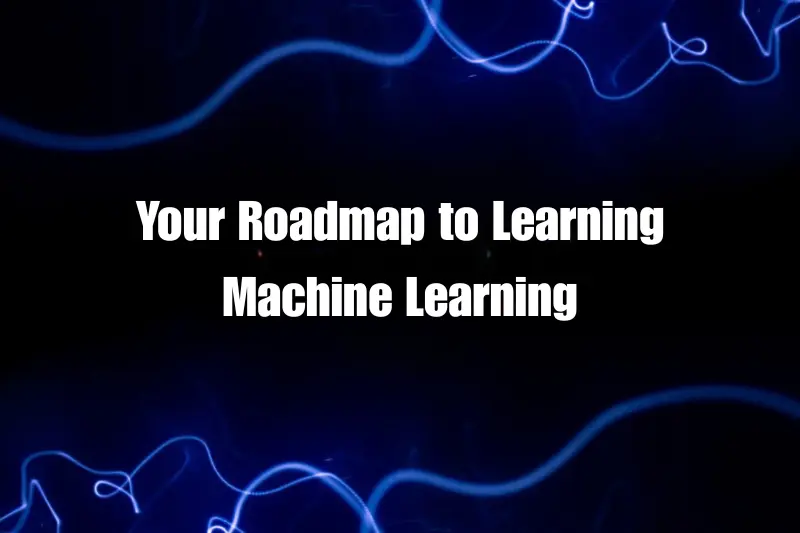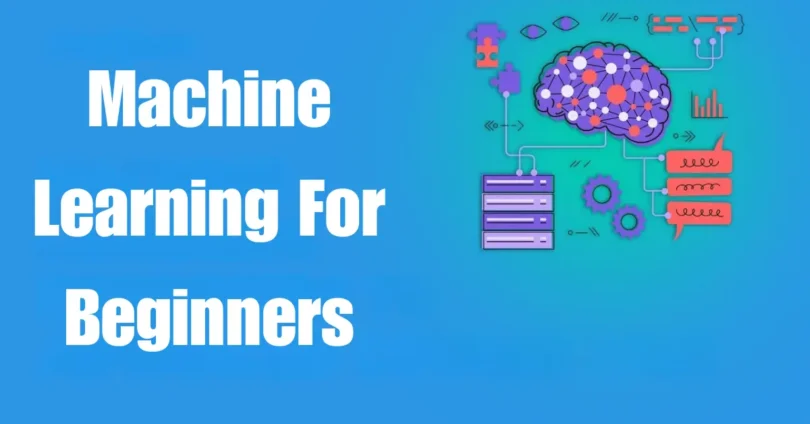Are you eager to dive into the world of machine learning for beginners but have no clue where to begin? You’re not alone—and you’re definitely in the right place! This article is your go-to beginner-friendly manual, packed with the right roadmap, helpful resources, and a clear explanation of concepts.
Whether you’re a student exploring career options, a professional seeking new skills, or someone fascinated by AI and data science, this guide will walk you step-by-step into the world of machine learning.
So, grab your digital notebook and let’s begin your exciting journey into the field of machine learning!
What is Machine Learning, Exactly?

Let’s break it down simply.
Machine Learning (ML) is a subfield of Artificial Intelligence (AI) that focuses on teaching computers to learn from data and make predictions or decisions without being explicitly programmed for every task.
Think of it like this:
You don’t tell a machine what to do; you show it examples, and it learns the rules itself.
For instance:
- Show an ML model hundreds of photos of cats and dogs — it learns to tell the difference.
- Feed it historical data about house prices — it learns how to predict future prices.
This ability to learn and adapt is what makes ML so powerful—and so relevant today.
Why Learn Machine Learning?
Here are just a few reasons why machine learning for beginners is such a hot topic:
It powers the tech we use daily: From Netflix recommendations to virtual assistants like Siri and Alexa.
It’s in demand: ML skills are highly sought after in industries like healthcare, finance, marketing, robotics, cybersecurity, and more.
It leads to exciting career opportunities: Roles like Data Scientist, Machine Learning Engineer, AI Specialist, and Researcher are in high demand.
It’s the gateway to advanced AI: Learning ML opens the door to exciting areas like deep learning, computer vision, and natural language processing.
Your Roadmap to Learning Machine Learning

Let’s walk through a beginner-friendly, step-by-step guide to get started with machine learning, including key topics and resources at each stage.
Step 1: Brush Up on the Basics
Before diving into algorithms and models, build a strong foundation in two key areas: mathematics and programming.
What to Learn:
- Linear Algebra: Vectors, matrices, dot products
- Calculus: Derivatives and gradients (basic understanding)
- Statistics & Probability: Mean, median, variance, probability distributions
- Python Programming: Variables, loops, functions, libraries
Resources:
- Khan Academy – Statistics and Probability
- Python for Everybody – Coursera
- W3Schools – Python Tutorial
You may also like to read this:
Top Educational Technology Trends 2025 Shaping Learning
Explore The Top Artificial Intelligence Trends For 2025 Now
Future Of Education 2025: Hybrid, AI, And VR Innovations
Blockchain Technology Explained: A Simple Guide
How AI Is Changing Industries: Trends To Watch In 2025
Future of Blockchain: What Lies Ahead in Tech
Step 2: Understand What Machine Learning Really Is
Familiarize yourself with the core types of machine learning and their real-world applications.
Types of ML:
- Supervised Learning – Learning from labeled data (e.g., house price prediction)
- Unsupervised Learning – Finding hidden patterns in data (e.g., customer segmentation)
- Reinforcement Learning – Learning through rewards and penalties (e.g., robotics, gaming)
Resources:
- Google’s Machine Learning Crash Course
- Introduction to Machine Learning – Andrew Ng (Coursera)
Step 3: Dive Into Core ML Algorithms
Now that you understand the ML types, it’s time to explore key algorithms. Don’t let the names intimidate you—they’re more approachable than you think!
Important Algorithms for Beginners:
- Linear Regression – For predicting continuous values
- Logistic Regression – For binary classification (e.g., spam or not spam)
- Decision Trees – For interpretability and easy decision-making
- K-Nearest Neighbors (KNN) – For classification based on closeness
- Support Vector Machines (SVM) – For separating data using optimal boundaries
- Neural Networks – Basic building block for deep learning
Resources:
- Machine Learning Mastery – Algorithm Guides
- Scikit-learn Documentation
Step 4: Practice, Practice, Practice!
Hands-on experience is key to learning ML. Start small and build up your skills with real datasets and simple projects.
Where to Find Datasets:
- Kaggle Datasets
- UCI Machine Learning Repository
Beginner-Friendly Project Ideas:
- Spam email classifier
- Predict student grades
- Build a movie recommendation engine
- Recognize handwritten digits (MNIST dataset)
Step 5: Learn Model Building & Evaluation
After you build your models, you need to evaluate how well they’re performing.
Key Concepts:
- Training vs. Testing Data
- Overfitting and Underfitting
- Performance Metrics:
- Accuracy
- Precision
- Recall
- F1-Score
- Confusion Matrix
- Accuracy
Resources:
- Analytics Vidhya – Evaluation Metrics
Step 6: Explore Advanced Topics
Once you’ve mastered the basics, level up with deep learning, natural language processing (NLP), and computer vision.
Advanced Areas:
- Deep Learning – Build artificial neural networks
- NLP – Work with human language (e.g., chatbots, sentiment analysis)
- Computer Vision – Analyze and process visual data (e.g., image recognition)
- AI Ethics – Learn how to build responsible AI systems
Resources:
- DeepLearning.AI – Deep Learning Specialization (Coursera)
- Fast.ai – Practical Deep Learning Course
Must-Read Books for Beginners
Here are some great books to support your learning:
Hands-On Machine Learning with Scikit-Learn, Keras, and TensorFlow by Aurélien Géron
Python Machine Learning by Sebastian Raschka
The Hundred-Page Machine Learning Book by Andriy Burkov
Tools & Libraries You Should Know
- Scikit-learn – Great for traditional ML models
- Pandas & NumPy – Data manipulation and numerical computing
- Matplotlib & Seaborn – Data visualization
- TensorFlow / PyTorch – Deep learning frameworks
These tools will be your everyday companions as you progress in your ML journey.
Keep Practicing: The Key to Mastery
When it comes to mastering machine learning, consistent practice is your superpower. Think of it this way: reading about riding a bicycle will never teach you how to balance on two wheels—you have to get on the bike. The same applies to ML.
Many beginners fall into the trap of endlessly watching tutorials or reading about algorithms without applying what they’ve learned. But real understanding comes from doing. The more you experiment with real datasets and build small applications, the more intuitive ML concepts will become.
Why Projects Matter
- Reinforce Learning: Hands-on work solidifies theoretical concepts.
- Build Confidence: Tackling real-world problems shows you that you can do it.
- Showcase Your Skills: Projects make your portfolio stand out when applying for internships or jobs.
- Get Comfortable with Tools: You learn essential libraries like pandas, scikit-learn, and TensorFlow naturally through usage.
Beginner-Friendly Project Ideas
Here are some fun, practical projects that are perfect for beginners:
1. Predict Stock Prices Using Linear Regression
- Learn to use time series or past stock prices to predict future values.
- Teaches regression techniques and data preprocessing.
- Dataset source: Yahoo Finance via yfinance Python library.
2. Classify Iris Flower Species with Decision Trees
- A classic beginner dataset with three flower types and four features.
- Helps understand classification and decision trees.
- Dataset: Built-in with scikit-learn.
3. Spam Detection with Naive Bayes
- Classify messages as “Spam” or “Not Spam” using text data.
- Excellent intro to Natural Language Processing (NLP).
- Dataset: UCI SMS Spam Collection.
4. Movie Recommendation System
- Use collaborative filtering to suggest movies based on user ratings.
- Offers exposure to recommendation systems and data filtering.
- Dataset: MovieLens Dataset.
Pro Tip: Don’t just build—explain your logic. Write blog posts or include detailed README files in your GitHub repos. This not only shows your understanding but also your ability to communicate technical ideas clearly—an essential skill in tech roles.
How to Document Your Projects on GitHub
A well-documented GitHub repository should include:
- A clear project description
- Instructions on how to run your code
- Jupyter notebooks (if applicable)
- Screenshots or visualizations of results
- A short section on what you learned
This will act as your public portfolio and proof of work!
Join the ML Community
Machine learning is a rapidly evolving field, and one of the best ways to stay ahead is by engaging with the global ML community. You don’t need to walk this learning path alone—there are thousands of learners just like you and experts eager to help.
Being part of a community offers:
- Support when you’re stuck
- Feedback on your work
- Inspiration from others’ progress
- Networking opportunities
Where to Join the Conversation
Kaggle Discussions
- Kaggle isn’t just for competitions—it has a vibrant forum where beginners ask questions, share notebooks, and get help.
- Join competitions to challenge yourself.
Visit: https://www.kaggle.com/discussion
Reddit – r/MachineLearning
- A mix of beginner and advanced discussions.
- Great place for staying updated with research, trends, and questions.
Visit: https://www.reddit.com/r/MachineLearning/
AI Stack Exchange
- A Q&A site where you can ask technical questions and get answers from experts.
- Excellent for debugging or theory-based clarifications.
Visit: https://ai.stackexchange.com
Towards Data Science (on Medium)
- Features tutorials, guides, and case studies written by ML enthusiasts and professionals.
- You can publish your own learning journey here!
Visit: https://towardsdatascience.com
Discord & Slack Groups
- Many online courses (like those on Coursera, Udemy, and Fast.ai) have Slack or Discord groups.
- Engage in discussions, collaborate on group projects, and ask questions in real-time.
Examples:
- Fast.ai’s official forum
- DataTalks.Club Slack community for data science lovers
Your Ideal Learning Timeline (Flexible for Beginners)
Here’s a sample 3-month plan you can follow:
| Timeframe | Focus Area | Goal |
| Week 1–2 | Python + Math Basics | Write basic Python scripts, understand stats |
| Week 3–4 | Intro to ML Concepts | Understand supervised & unsupervised learning |
| Week 5–8 | ML Algorithms | Learn Linear Regression, KNN, Decision Trees |
| Week 9–10 | Model Evaluation + Projects | Work on mini-projects, evaluate models |
| Week 11–12 | Deep Learning Basics | Understand neural networks & start DL course |
Remember, you can stretch this plan to fit your schedule—it’s not a race. Quality learning matters more than speed.
Final Tips for Machine Learning Beginners
Start small and consistent – Don’t aim to learn everything at once. Focus on one topic a week.
Build projects early – Practical learning helps you retain more.
Join the community – Reddit, Kaggle forums, and Discord groups are full of helpful people.
Stay updated – Follow blogs like Towards Data Science, listen to AI podcasts, and subscribe to YouTube channels like StatQuest or 3Blue1Brown.
Conclusion
Machine learning for beginners may feel overwhelming at first, but with patience and consistent effort, anyone can grasp its concepts and apply them effectively. The most important thing is to start small, keep practicing, and build real projects to reinforce your learning.
Engage with communities, seek help when needed, and stay curious. Machine learning for beginners is not just about theory—it’s about doing, experimenting, and growing step-by-step.
Remember, every expert started as a beginner. Your commitment today will open doors to exciting opportunities in AI and data science. So take the first step confidently and enjoy the rewarding journey of machine learning for beginners!



